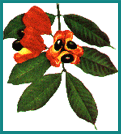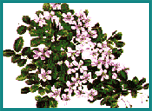Our Family History


Pauline Owens
My mother, was the sixth child of my grandparents. She was very close to her father Alexander. While Alexander loved all of his children very much, Pauline and her father had a very special bond. She looked exactly like him. They were so close, that everyone at home and in the Richmond district called her Miss Alex...

Ellen Owens
ELLEN, the seventh child, was named after her grandmother. Following her parents death she moved to Richmond to find work. Her older sisters had already left for Richmond, paving the way for her. The job market in Richmond was not as strong and Ellen struggled to find work. It was not long after, she moved to Kingston, following her sister Elsie who was already there...
About Jamaica

National Fruit –
The Ackee (Blighia sapida)
“Carry me ackee go a Linstead Market, not a quattie wut sell” is a line in the popular Jamaican folk song ‘Linstead Market’. Ackee is the national fruit of Jamaica as well as a component of the national dish – ackee and codfish.
Although the ackee is not indigenous to Jamaica, it has remarkable historic associations. Originally, it was imported to the island from West Africa, probably on a slave ship. Now it grows here luxuriantly, producing large quantities of edible fruit each year.
Ackee is derived from the original name Ankye which comes from the Twi language of Ghana. The botanical name of the fruit – Blighia Sapida – was given in honour of Captain William Bligh of “Mutiny on the Bounty” fame, who in 1793 took plants of the fruit from Jamaica to England. Captain Bligh also brought the first breadfruit to Jamaica. Before this, the ackee was unknown to science. In 1778 Dr Thomas Clarke, one of the earliest propogators of the tree, introduced it to the eastern parishes.
The ackee tree grows up to 15.24m (50ft) under favourable conditions. It bears large red and yellow fruit 7.5 – 10 cm (3-4 in.) long. When ripe these fruits burst into sections revealing shiny black round seeds on top of a yellow aril which is partially edible.
There are two main types of ackee identified by the colour of the aril. That with a soft yellow aril is known as ‘butter’ and ‘cheese’ is hard and cream-coloured. Ackee contains a poison (hypoglcin) which is dissipated when it is properly harvested and cooked. The fruit should not be gathered until the pods open naturally. In addition, the aril must be properly cleaned of red fibre and the cooking water discarded.
Jamaica is the only place where the fruit is widely eaten. However, it has been introduced into most of the other Caribbean islands (for example, Trinidad, Grenada, Antigua and Barbados), Central America and Florida, where it is known by different names and does not thrive in economic quantities. Jamaican canned ackee is now exported and sold in markets patronized by expatriate Jamaicans.
Ackee is a very delicious fruit and when boiled and cooked with seasoning and salt fish or salt pork, it is considered one of Jamaica’s greatest delicacies.

The Jamaican Coat of Arms
The Jamaican national motto is ‘Out of Many One People’, based on the population’s multi-racial roots. The motto is represented on the Coat of Arms, showing a male and female member of the Taino tribe standing on either side of a shield which bears a red cross with five golden pineapples. The crest shows a Jamaican crocodile mounted on the Royal Helmet of the British Monarchy and mantling.

National Flower – Lignum Vitae (Guiacum officinale)
The Lignum Vitae was found here by Christopher Columbus. Its name, when translated from Latin, means “wood of life” – probably adopted because of its medicinal qualities. The short, compact tree is native to continental tropical American and the West Indies. In Jamaica it grows best in the dry woodland along the north and south coasts of the island.
The plant is extremely ornamental, producing an attractive blue flower and orange-yellow fruit, while its crown has an attractive rounded shape. The tree is one of the most useful in the world. The body, gum, bark, fruit, leaves and blossom all serve some useful purpose. In fact, the tree has been regarded for its medicinal properties. A gum (gum guaiac) obtained from its resin was once regarded as a purgative. It was exported to Europe from the early sixteenth century as a remedy (combined with mercury) for syphillis and has also been used as a remedy for gout.
The wood was once used as propeller shaft bearings in nearly all the ships sailing the ‘Seven Seas’. Because of this, Lignum Vitae and Jamaica are closely associated in shipyards worldwide. It is a very heavy wood which will sink in water. Because of its toughness it is used for items such as mortars, mallets, pulleys and batons carried by policemen. Sometimes it is used for furniture.

National Tree – The Blue Mahoe (Hibiscus elatus)
The Blue Mahoe is the national tree of Jamaica. It is indigenous to the island and grows quite rapidly, often attaining 20m (66ft) or more in height. In wetter districts it will grow in a wide range of elevations, up to 1200m (4000 ft.) and is often used in reforestation.
The tree is quite attractive with its straight trunk, broad green leaves and hibiscus-like flowers. The attractive flower changes colour as it matures, going from bright yellow to orange red and finally to crimson.
The name mahoe is derived from a Carib Indian word. The ‘blue’refers to blue-green streaks in the polished wood, giving it a distinctive appearance.
The Blue Mahoe is so beautiful and durable that it is widely used for cabinet making and also for making decorative objects such as picture frames, bowls, and carving.
The inner bark of the tree is often referred to as Cuba bark because it was formerly used for tying bundles of Havana cigars. Cuba is the only other place where the Blue Mahoe grows naturally.
All photos of Jamaica and content
have been used from www.jis.gov.jm/special_sections/


The Owens Family





